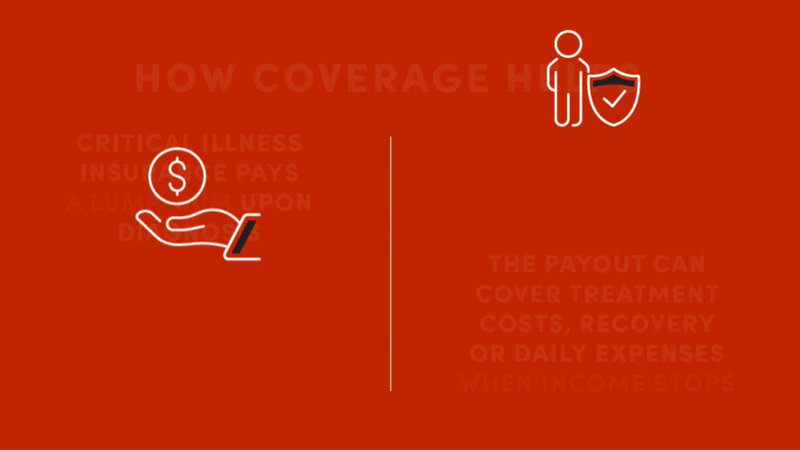The financial impact of a serious illness often extends far beyond hospital bills. Many Singaporeans assume that their MediShield Life or hospitalisation insurance plans will cover them fully during these difficult periods. In reality, those plans pay only for your medical expenses and do not cover the income lost when you have to stop work. Daily costs such as mortgage payments, grocery bills, utilities and other loans still have to be paid while patients recover.
This difference between what is covered and what you need is known as the protection gap. It can leave households struggling financially when recovery stretches over months or even years. The scale of the problem is significant. According to the Life Insurance Association of Singapore (LIA), working adults face an estimated 74 per cent shortfall in critical illness coverage, meaning most would struggle to meet financial commitments if they get a critical illness and have to stop work.

HEALTH TRENDS SHAPING THE PROTECTION GAP
Critical illness refers to major health conditions such as cancer, stroke, heart attack or kidney failure – conditions that can affect one’s ability to work or live independently. In Singapore, these diseases are becoming increasingly common. The Singapore Cancer Society notes that about one in four Singapore residents is likely to develop cancer in their lifetime, while the Singapore Stroke Registry Annual Report 2022 shows stroke cases rose by more than 50 per cent between 2012 and 2022.
The trend also shows that more younger people are being diagnosed with critical illnesses. According to the Singapore Cancer Registry Annual Report 2022, the sharpest rise in cancer cases in recent years has been among those under 50, particularly people in their 30s and 40s. The number of younger Singaporeans diagnosed with cancer increased by about 90 per cent between 1988–1992 and 2018–2022.


Recovery, too, can be uncertain. For some cancers, a relapse can occur years after treatment, while stroke survivors face up to a 15 per cent recurrence risk each year. When recovery is prolonged or illness returns, both the financial strain and protection gap grow.
The good news is that medical progress has changed the outlook for many conditions. With advancements in cancer treatments, survival rates have risen, and better screening for some common cancers has led to earlier detection and timelier treatment, according to the National Cancer Centre Singapore. This also means individuals need to be protected if they get an early diagnosis.
As health risks evolve, one challenge persists: Many people misunderstand what their insurance covers. According to Mr Shawn Tan, head of partnership distribution at Singlife, confusion about coverage remains common. “People often mix up hospitalisation insurance with critical illness coverage because both relate to health events,” he said.

Another misconception is that critical illness coverage is unnecessary for the young and healthy. “Serious illnesses can strike at any age, and once a critical illness is diagnosed, getting new coverage is nearly impossible – which is why ongoing protection matters,” he said. Singlife’s Multipay Critical Illness II plan*, for example, allows multiple claims and offers higher payouts for recurring conditions, thereby ensuring continuous financial support when it is needed most.


HOW COVERAGE CLOSES THE GAP
Closing the protection gap means thinking beyond hospital bills. When a major illness prevents someone from working, families must still manage ongoing expenses and loan commitments.
Critical illness insurance helps cushion these families by giving a lump-sum payout on diagnosis of an illness. This gives policyholders flexibility to use the money to cover treatment or recovery-related costs – such as ensuring proper nutrition for the patient during recovery, household bills and loans – without draining long-term savings or retirement funds. This financial buffer helps families should a family member fall ill and need extended treatment.
With medical advancements and earlier screenings, illnesses are being detected sooner. This makes early-stage critical illness protection even more important, as it provides immediate financial relief at the start of treatment, when income often stops but costs surge.

“With more people being diagnosed at earlier stages, protection needs to start earlier too,” said Mr Tan. “Families can no longer assume that a serious illness is a ‘later life’ concern. Planning early helps cover income loss and daily expenses before conditions become severe.”
Continuous protection is equally crucial for conditions that may recur or worsen. “Having a plan that allows multiple claims or covers recurring conditions means your protection doesn’t end after the first diagnosis,” he added. “It helps families stay financially supported through long recoveries and relapses, so they can focus on getting better.”
Together, these forms of coverage bridge the gap between medical recovery and financial stability, ensuring that health shocks do not derail long-term plans. Ultimately, the goal is lasting peace of mind – but achieving that starts with planning ahead.


PLANNING WITH CONFIDENCE
Many still postpone buying critical illness insurance, often viewing it as something to address later in life. Yet starting protection early can make a meaningful difference. Premiums are typically lower when bought at younger, healthier stages of life, and coverage can continue through milestones such as buying a home or raising a family. Early planning also protects long-term savings. With proper coverage, emergency savings and retirement funds need not be tapped if illness disrupts income.
A flexible plan lets you adjust coverage as your circumstances evolve, without having to reapply later. Features such as the Advance Care Option under Singlife’s Multipay Critical Illness II plan provide additional payouts upon diagnosis of serious illnesses, offering support when it matters most.
According to the LIA, a useful rule of thumb is to hold critical illness coverage worth around four times one’s annual income. This aims to cover medical expenses, living costs and income loss during recovery. But knowing the amount alone is not the whole story. Timing matters, too. “Premiums rise with age, and once a health issue appears, it can be harder or even impossible to get covered,” Mr Tan said.
Younger adults, in particular, often prioritise short-term goals such as holidays or home ownership and may overlook critical illness coverage because they feel healthy. Planning earlier and maintaining protection over time helps narrow the protection gap and strengthens long-term financial resilience.
*This product is underwritten by Singapore Life Ltd.
Disclaimer:
This article is published for general information only and does not have regard to the specific investment objectives, financial situation and particular needs of any specific person. Buying a health insurance policy that is not suitable for you may impact your ability to finance your future healthcare needs. This advertisement has not been reviewed by the Monetary Authority of Singapore. Protected up to specified limits by SDIC.
Information is correct as at November 27, 2025.













